Churn Analysis: Definition, Ways to Do it, & How to Monitor it
Learn everything you need to know about churn analysis and how to do it right. Discover the common causes of churn and ways to improve customer retention.

This post was last updated on January 27, 2025
What is Churn in B2B SaaS?
What are the Causes of B2B SaaS Churn?
What is Churn Analysis?
Why is Churn Analysis Important?
How to Conduct a Churn Analysis
B2B Customer Retention Strategies to Reduce Churn
FAQ
Conclusion
High churn rates are a major problem for B2B SaaS companies.
Unlike B2C companies, which can acquire customers in bulk, the customer acquisition costs for B2B companies can be quite high. Given the time, money, and effort it takes to acquire a new client, losing even a single customer takes a toll on a SaaS business.
That’s where churn analysis can be useful.
By tracking and analysing your churn rates, you can understand the causes of churn and take corrective action. Churn analysis also helps you predict future churn and prevent it.
But how can you conduct a churn analysis?
Read this detailed guide to learn all you need to know about churn analysis and how to do it.
Also Read:
- How to Reduce Churn (with Subscription Billing & AI-Powered Customer Success)
- Reducing Churn: AI Customer Success Meets Subscription Billing
What is Churn in B2B SaaS?
In B2B SaaS, churn refers to the phenomenon of clients canceling or downgrading their subscriptions.
For a B2B SaaS business, churn happens when a client:
- Cancels their existing subscription
- Doesn’t renew their subscription
- Switches to a competitor
- Downgrades or makes a partial cancellation
Churn is bad for any business as it causes a loss of revenue and can stump business and revenue growth. That’s why understanding why churn happens and how you can avoid it is important. Churn analysis can help you with that.
Voluntary vs Involuntary Churn
Voluntary churn occurs when a customer intentionally chooses to cancel or not renew their subscription. This could be because they’re dissatisfied with your product or service, or they found a better offer somewhere else.
However, in B2B SaaS, not all churn is voluntary. Sometimes, there could be payment issues, such as sending the wrong invoice. This may cause payment delays. And if the customer gets frustrated, they may churn. Using a good subscription billing software solution like Younium can help avoid such mistakes and elevate your payment experience.
Revenue vs Customer Churn
The most common way to measure churn is by calculating the customer churn rate. This shows the percentage of customers that left during a period over the total number of customers at the beginning of a period.

Another way to calculate churn is to calculate the revenue lost during a period. This doesn’t just include canceled subscriptions but also includes other forms of revenue loss, such as downgrades or payment failures.
Here’s the formula for calculating Revenue Churn.

You can calculate your SaaS churn rate on a monthly or yearly basis.
Now that you have a clear understanding of B2B SaaS churn, let’s discuss what causes it, as it will help you in churn analysis.
Also Read:
- What is a Good Churn Rate for SaaS Companies? Benchmarks
- Ways to Sustain & Grow Revenues During Renewals
What are the Causes of B2B SaaS Churn?
Before we discuss how to do churn analysis, let’s first understand the common causes of B2B SaaS churn.
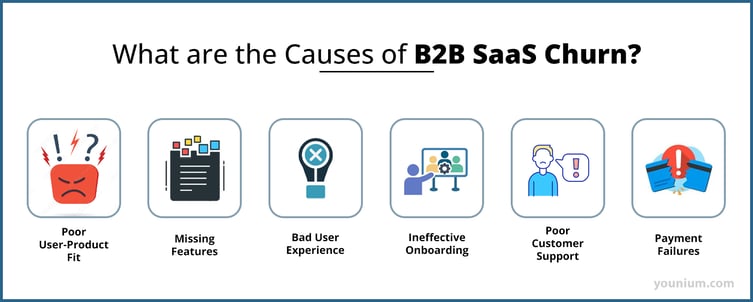
1. Poor User-Product Fit
One of the common causes of B2B SaaS churn is when businesses sell to the wrong customers. If someone subscribes to your product and realises that it’s not the right fit for them, they’re bound to leave.
This not only leads to a high churn rate but also a waste of resources you spend on winning and onboarding those customers.
Solution
To avoid this situation, you should have a clear market positioning and be transparent about what you offer and who your target customers are.
Start by creating an ideal customer profile (ICP) and targeting your sales efforts on key accounts, instead of casting a wide net.
2. Missing Features and Functionality
Another reason why your customers may leave is if they are not satisfied with your product. If your product lacks certain features and functionality, then it will not help your customers achieve the desired results.
In this case, they will switch to a competitor who provides the features they need.
Solution
Create a product and add features that focus on your target market (ideal customer profile). Regularly touch base with users and collect their feedback. Identify the areas of improvement and missing features and regularly update your product to better meet your customers’ needs.
3. Bad User Experience
During churn analysis, you may also find that your customers are churning because of poor experience with your product.
Even if your product has all the features your customers need, they can still have a poor experience with it if the user interface is not great. Poor navigation and usability can cause frustration among customers, leading to customer churn.
Solution
Consistently work on improving your product’s interface based on customer feedback and usability testing.
4. Ineffective Onboarding
Customer onboarding plays a crucial role in customer satisfaction and retention. If you provide a good onboarding experience and give your customers the knowledge they need to make the most of your product, they’ll be happy with it. It helps improve subscription renewal rates.
On the other hand, if you make a poor first impression or don’t onboard customers properly, they may not get the best use of your product. This, inevitably, leads to customer churn.
Solution
Brainstorm and create a great onboarding program for your customers. Focus on welcoming them and equipping them with all the resources they need to use your product successfully.
Keep your onboarding short and efficient to enable users to master the basics and start using your product quickly, instead of being stuck in a long onboarding process. This will help you reduce churn and improve customer retention.
5. Poor Customer Support
Poor customer support is one of the causes of churn you’ll find in your churn analysis.
Non-responsive, slow, or ineffective customer support is one of the biggest causes of customer dissatisfaction, which inevitably causes churn.
You may have the best product on the market but still have high customer churn if you do not provide great customer support.
Solution
Offer support through multiple channels, such as phone, chat, and email. Set hard deadlines for your support team members for how long they can take to respond via each channel. Train them to be in a position to handle all types of customer queries. Regularly collect user feedback on their experience with your support team and level of satisfaction with the resolution provided.
6. Payment Issues
Sometimes, churn happens because a customer receives a wrong invoice or there is some other payment-related issue. If the pricing is not transparent or if there’s an unexpected price increase, then that causes trust issues.
If such mistakes happen often enough, customers may get frustrated and churn.
Solution
This type of churn can be easily avoided with the use of a good subscription management software solution. Such solutions offer recurring billing, invoicing, and other payment-related features that can streamline the payment process for your B2B SaaS business.
Maintain transparent pricing and if the subscription prices increase, proactively inform your customers.
Also Read:
- How to Improve Subscription Renewal Rates
- Navigating Renewals in the Shifting Landscape of SaaS Businesses
What is Churn Analysis?
Churn analysis refers to the process of monitoring churn rates for your business to draw insights into why customers churn.
It involves regular tracking and assessment of churn rates to understand the causes of churn and predict churn before it happens. Churn analysis helps you maintain a good churn rate and boost customer retention and subscription renewals.
Also Read:
- How to Introduce Changes to Contracts in Renewal Periods
- Why SaaS Companies are Missing Opportunities for Customer Renewals
Why is Churn Analysis Important?
By understanding the causes of churn and predicting it, you can be better prepared to handle it. Customer churn analysis allows you to identify at-risk customers and retain them by solving their problems with your product or service.
Let’s discuss three of the most important benefits of conducting a churn analysis for your B2B SaaS business.
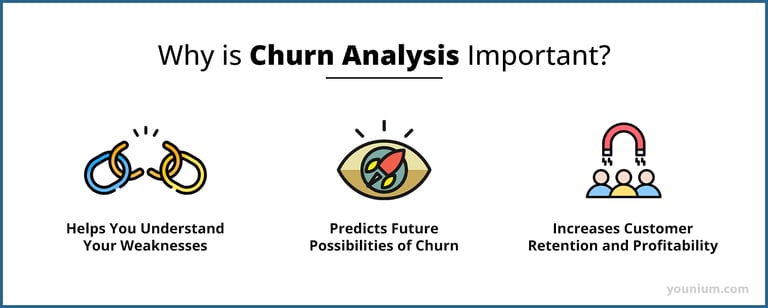
Helps You Understand Your Weaknesses
Churn analysis helps you understand the reasons why your customers are leaving. Is it due to poor customer service or poor product-customer fit? Or maybe your competitors are offering better features or deals.
Whatever the reasons may be, churn analysis can help you uncover them and identify areas of improvement.
Predicts Possibilities of Churn and Reduces Future Churn
Churn analysis can also help you identify at-risk customers, based on their history with your business. You can use customer data and previous feedback to segment customers based on their likelihood to leave your business.
The ones that have a high likelihood of leaving should be your primary focus. You can take proactive measures to resolve their issues and retain them, improving your churn rate.
Increases Customer Retention and Profitability
Churn analysis helps you boost customer retention and profitability.
When you anticipate churn and proactively reach out to your customers and help resolve their problems, you show them that you care. This is a great way to build lasting customer relationships and improve customer retention and loyalty.
Not to mention, when your churn rate is low and you retain most of your customers, your profitability increases as well.
Also Read:
How to Conduct a Churn Analysis
Here’s a step-by-step guide to conducting an effective customer churn analysis for your B2B SaaS business.
1. Use Subscription Analytics to Track Key Metrics
The first thing you need to conduct an accurate churn analysis is a good subscription analytics solution. Younium’s subscription insights feature, for example, is a great solution to help you get a whole range of insights into your customers and SaaS metrics.
By centralising customer data, Younium can help you quickly gather invaluable insights into product usage patterns, customer feedback, and payment history. This data will form the basis for churn analysis.
Once you have a good SaaS analytics tool, use it to gain actionable insights into the following areas.
Customer Engagement and Usage
Track how engaged your customers are and how frequently they are using your product. A low or declining usage rate is a sign that the customers are not finding your product useful. And if that’s the case, they’re not likely to continue paying for it.
Younium’s subscription insights feature, for example, can help you track churn indicators like declining usage, missed payments, or decreased engagement.
Customer Support Tickets
During your churn analysis, analyse data from your customer support tickets to identify:
- What are the common challenges faced by your customers?
- Which product features need improvement?
- Which customers have submitted the most tickets and have faced regular issues?
The first two will help you improve your product to reduce churn organically. The last one will help you identify dissatisfied customers.
You should also track an increase or decrease in the number of support tickets for a set period.
If the number of tickets is declining, then that’s a sign that you’re doing your job well, and most customers are satisfied with your product. However, if the number is rising, then that is an indication that there’s a problem that you need to address.
But don’t just look at absolute numbers while doing your churn analysis. You should also track this in relation to the increase in customers. If the number of tickets is increasing at a lower rate than the rate of increase in customers, then that’s a good sign.
Feedback From Surveys
Regularly conduct surveys to collect customer feedback and gain insights into their key challenges with your SaaS product. This will help you identify the key reasons why customers leave your company and switch to a competitor.
Based on customer feedback, you can suggest new features to address the common issues users face.
2. Segment Customers to Identify At-Risk Customers
The second step in churn analysis is to identify customers who are at risk of churning.
Now that you have all the data you need to understand why customers leave, you need to identify which customers are most likely to leave.
The best way to do this is to segment your customers based on their engagement with your product and history with your business.
Run a cohort analysis to segment your customers based on their product usage patterns. You create customer cohorts based on the month when they sign up or start paying for your SaaS product.
Advanced subscription management software solutions offer a cohort analysis feature, which makes this easier for you.
You then track and analyse churn rates across the lifetime of each cohort to identify how long after signing up most customers leave. Here’s an example of a cohort analysis.
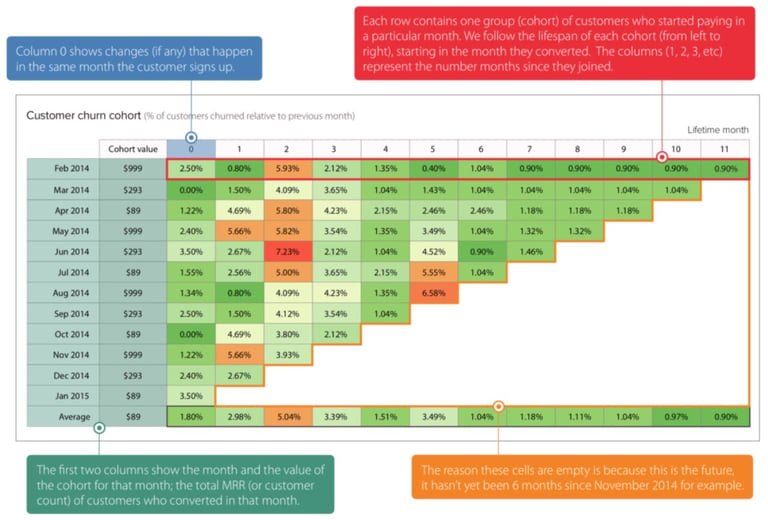
Image via ChartMogul
The above method is good for understanding churn for your business. However, if you want to identify at-risk customers, then you can create cohorts based on sign-up month and product usage rates.
Instead of the churn rate, track the average monthly recurring revenue (MRR) for each cohort to identify cohorts with declining product usage. Younium, for example, helps you track the Contracted Monthly Recurring Revenue, under its insights dashboard.
This will help you identify the customers who are likely to leave after a specific period. Advanced subscription management software solutions like Younium offer predictive analytics, which can predict the likelihood of churn for individual customers, based on historical data and behavior patterns.
Such tools can also send alerts for churn indicators and help you identify customers who are about to churn.
You can pay extra attention to these customers and try to retain them before they reach a point where they decide to discontinue using your product.
Other Ways to Use Customer Segmentation for Churn Analysis
Other than segmenting customers by usage patterns and behaviors you can group them by industry, location, or pricing tiers for churn analysis. These can give useful insights into customer behavior patterns and help you reduce churn.
Here are some tips to segment customers for churn analysis:
- Identify patterns of behavior among customers from different industries. Do users from certain industries find your product more useful than others? If so, what features can you add to retain customers from segments with low engagement?
- Sometimes, customers at low pricing tiers may be at higher risk of churn due to budget constraints or lack of features offered with their plan. In such cases, you can offer better features and more value than what competitors offer. Most prospects will exceed their budget slightly if they’re getting more value.
By segmenting your customers and observing the behaviors of various segments, you can draw valuable insights during churn analysis. Don’t be limited by the few methods of segmentation we’ve discussed here, but experiment with more parameters relevant to your business.
3. Measure Your Current Churn Rate
We’ve already discussed the basics of churn analysis, but here we’ll give you more specific ways to measure the churn rate for your B2B SaaS business.
To measure revenue churn, divide the difference between total revenue lost in a period and new revenue gained during the period, by the revenue at the start of the period. Multiple this by 100 to get Net Revenue Churn.

You can use monthly or annual revenue to make this calculation and arrive at your Net Monthly Revenue Churn Rate or Net Annual Revenue Churn Rate.
If you have access to Contracted Annual Recurring Revenue (CARR) and Contracted Monthly Recurring Revenue (CMRR) numbers, then that would be a better way to calculate it. Younium provides the CMRR data in its insights dashboard dashboard, along with other revenue metrics.
Now, if you want to calculate your Net Customer Churn Rate, use the following formula.

There you have it—quantitative ways to measure churn for your churn analysis.
Keep track of the customer churn data consistently to identify trends and patterns that can help you reduce churn.
These insights can also help you make financial projections, such as a cash flow forecast. This helps you with better financial planning.
4. Understand the Causes of Churn
So far we’ve covered the possible causes of churn, but here we’ll discuss ways in which you can identify these for your business.
Not all causes of churn may be applicable to every business.When doing a churn analysis, you need to understand exactly why your customers are churning.
Here are a few ways to understand the causes of churn for your business during churn analysis.
Exit Surveys
Ask your churning customers directly why they left your business by conducting exit surveys. This is the most accurate way to identify causes of the churn during churn analysis.
Ask your customer service representatives to send an exit survey, as soon as a customer cancels their subscription.
Here’s a sample exit survey template for customer churn that you can use.
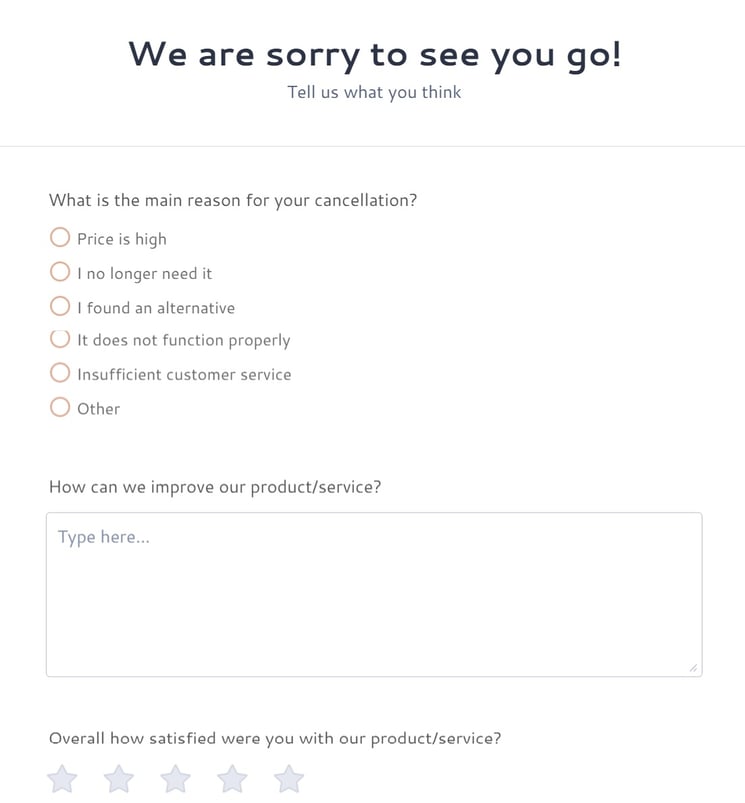
Image via Jotform
NPS Surveys
Net Promoter Score surveys are short, yet effective. They ask your customers to rate your product on a scale of 1 to 10 and have an open-ended question to share the reasons for the score.
Analyse the qualitative responses shared via such surveys to understand why some customers gave you a low score.
Social Listening
Use social media monitoring tools to listen in on social conversations related to your brand or product.
Given that people often vent about brands on social media rather than complain through official channels, you can gain new insights from this activity.
Make sure you’re not just a passive listener, but an active participant in social media conversations related to your brand. Respond to both positive and negative comments politely and respectfully.
Try to learn more about the problems your customers are facing by asking follow-up questions.
Also Read:
- An Introduction to Subscription Management for B2B SaaS Companies
- What is Subscription Management? A Guide for SaaS Businesses
B2B Customer Retention Strategies to Reduce Churn
After you’ve done churn analysis and identified at-risk customers, you’ll need to take measures to retain those customers.
Here are some of the best practices and strategies to boost customer retention and reduce churn.
1. Provide a Great Onboarding Experience
Customer onboarding is more than just a formality. It’s a way for you to make a good first impression on your new customers and begin a long and fruitful relationship.
Here’s a simple onboarding process followed by basic SaaS companies. You can customise this to suit your business’s unique requirements.
- Ask new users how they plan to use your product and what goals they want to achieve with it.
- Give a demo of your product. Show its key features, relevant to each user, and how to use them, and give an overview of how to navigate the user interface.
- Send a welcome email thanking a customer for choosing you and providing clear next steps on how they should set up their account. Provide a custom invitation tailored to your customers’ specific needs, offering them an exclusive introduction to your product or service.
- If you offer any learning resources or tutorials, tell new users where they can find those.
- Inform them of the various ways in which they can contact you and assign a dedicated point of contact for your top-tier customers.
- Conduct a welcome survey to assess your new customers’ needs and preferences, and offer personalised solutions to them.
Here’s a great example of a welcome email by Miro. It provides all the necessary information a new customer will need to set up their account and start using the platform.
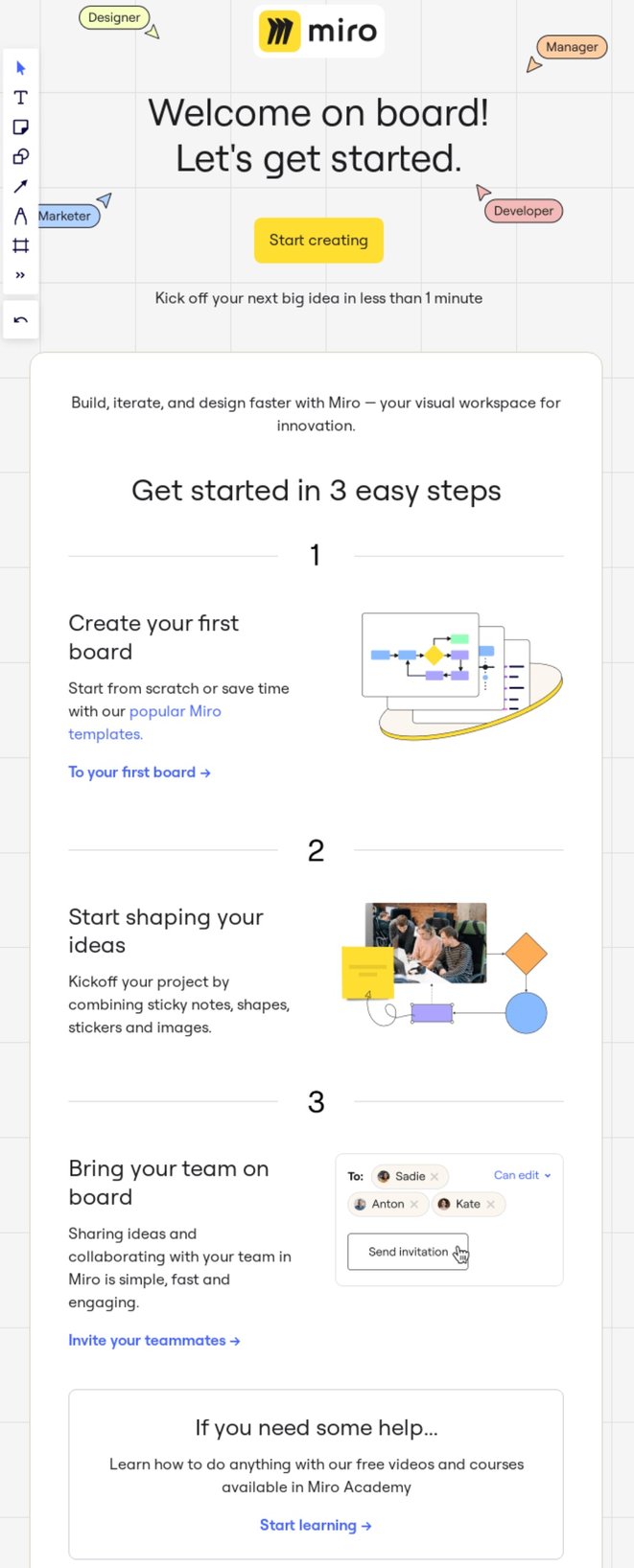
Image via Really Good Emails
2. Train and Educate Your Customers
One of the causes of churn, especially in the B2B SaaS industry, is that users find it difficult to use all the features of a product and switch to an easier alternative. Your churn analysis will confirm this.
You may have a great, innovative product with unique features, but it’s of no use to a user who doesn’t know how to use it. As such, it’s crucial that you educate and train your customers on how to use your product effectively, every step of the way.
Here are some tips to get you started:
- Create an AI video demo of your product or, better yet, do a one-on-one product demo for each customer when they first subscribe to your plans.
- Create in-depth guides on using the various features of your product and navigating through the interface.
- Use a mix of blog posts, technical guides, videos, and other formats to cater to users with different learning styles.
- Assign a success advisor to your top-tier clients, who will provide personalised guidance to them.
- Create a help center or knowledge hub, which acts as a repository for all learning resources for your SaaS product. Make sure it’s exhaustive and covers everything.
- Add a FAQ page on your website to make it easier for new customers to find answers to common questions.
Younium, for instance, has a Knowledge Hub where users can find blog posts, webinars, extensive product documentation, videos, templates, and tons of other learning resources. It also assigns a dedicated success manager to each client to help them use the product to achieve their goals.
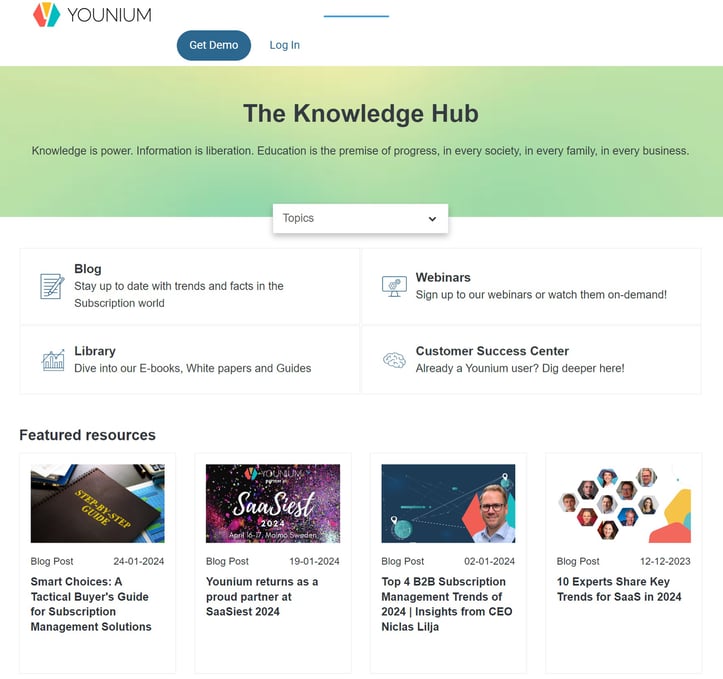
Image via Younium
3. Provide Incentives for Long-Term Subscriptions
One way to reduce churn is to get customers to subscribe to long-term plans. This doesn’t ensure that they’ll not leave after the term is over or even before, but customers who stick around longer have more time to get used to the product and user interface.
In B2B SaaS, it’s all about familiarity and ease of use. If someone has taken the time to master your product and has grown comfortable with it, then they’ll hesitate to leave unless there’s no other choice.
It’s easier to retain your long-term customers as you have the time to build a rapport with them. Someone who’s subscribed to a monthly plan, on the other hand, has nothing to lose and can make a quick exit decision.
So how can you get more customers to subscribe to long-term contracts?
Here are a few tips:
- Offer a flat discount on annual or other long-term plans.
- Give progressively higher discounts for longer plans, if you offer several long-term subscription options. Or you can add free add-on features for longer subscriptions.
- Make sure you clearly convey the benefits of opting for long-term subscriptions to prospective customers.
- Clearly disclose your cancellation policy and terms if a customer decides to cancel their subscription before the term is over.
4. Offer Free Trials and Freemium Plans
As previously mentioned in this guide on churn analysis, three of the biggest causes of churn are poor product-customer fit, missing features, and poor customer experience.
You can prevent churn due to all three by offering a free trial or a freemium plan.
Both of these allow businesses to try your platform and assess if it meets their expectations. Here’s how offering free access can help reduce churn:
- It allows businesses to see if the platform has all the features they need.
- It gives relevant people from your target businesses a chance to try your product and see if this is what they are looking for. Clients who are not a good fit for your product can leave at this stage.
- It gives end users from target companies a sense of how easy or difficult it is to navigate through and use the platform. Anyone facing usability issues can leave after the free trial instead of paying for a subscription, canceling, and leaving dissatisfied.
Another benefit of giving free access is that your prospective customers get to see how great your product is and can confidently subscribe to long-term plans.
Offering a free trial doesn’t just weed out misfits, but gives your target customers a chance to experience your product first-hand. This improves retention because people go in knowing exactly what to expect, instead of getting unpleasantly surprised later.
However, there’s a downside to this as well. If a client has a bad experience during the trial period, because of a poor demo video or lack of support, they might not proactively reach out and just reject your offering.
HubSpot, for example, offers a free plan with access to all its free tools and starting features. Clients can try it out before upgrading to one of its paid plans.
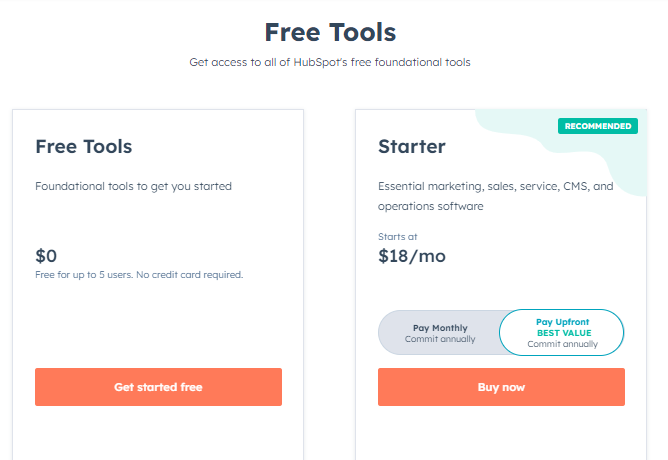
Image via HubSpot
5. Regularly Seek and Work on Customer Feedback
There’s no better way to understand why customers are dissatisfied with your product or service than to ask them directly.
That’s why it’s important to regularly collect customer feedback, at various touchpoints.
- Someone just signed up for your free trial? Ask them how their experience was through a short survey.
- Did a customer upgrade or downgrade their subscription plan? Ask them for the reasons why they made the decision.
- Did a customer cancel their subscription and choose to end their business with you? Ask your customer service representatives to reach out to them and collect feedback.
Collect customer feedback at every turn and corner. Show genuine interest in understanding whether your customers are happy with your product.
Collate all customer feedback to identify common threads
- Is there a particular feature that most customers struggle with?
- How satisfied are your customers with your customer support?
- If they are dissatisfied with customer service, why?
- Are there any missing features that many customers want you to include?
- Is the interface user-friendly? Do customers find it easy to use your product?
Identify all areas for improvement and common challenges and work on them.
It’s not enough to simply understand customer needs. You need to take corrective action and solve your customer’s problems to improve retention.
By taking action based on customer feedback, you show them that you care and that you are continually improving your product(s) and services to meet their needs. This builds trust and fosters customer loyalty.
6. Consistently Update and Upgrade Your SaaS Product
Any successful SaaS business owner knows that there’s no such thing as a perfect product. You continually need to improve your product to meet the dynamic industry and consumer needs.
What may have been a new and innovative SaaS product five years ago, may now have become an everyday product with numerous competitors.
The key to winning the SaaS game is staying on top of the latest SaaS trends and keeping your product updated to meet the current needs of your customers.
There are two key aspects to this:
- Run tests and regularly update your product to fix bugs and usability issues.
- Add new features and functionality to upgrade your product to meet the current industry standards.
Younium, for example, frequently updates its product features and user interface.
7. Provide Exceptional Customer Support
Irrespective of how great your SaaS product is, you may still witness customer churn if your customer service is not up to the mark.
Neglecting customer service is not an option. You need to go above and beyond to meet customer needs and resolve their problems promptly while delivering a great experience.
Here are some tips to improve customer service:
- Provide multiple support channels, such as email, live chat, and phone.
- Offer an omnichannel support experience by ensuring your support executives have the previous customer interaction history from all channels.
- Train your support team and ensure they maintain fast turnaround times for problem resolution.
- Offer customer self-service tools and resources for common queries and issues.
- Provide dedicated or priority support to your top-tier and high-value customers.
Most subscription management software integrate with CRM systems to centralise all customer data and improve collaboration between teams. This allows support teams to have all the customer data and history they need to deliver personalised customer support, thus boosting retention.
Also Read:
- What is Subscription Billing? A Guide for SaaS Businesses
- How to Streamline Financial Processes with Subscription Billing Platforms
FAQ
Q1. What does churn tell you?Churn measures the rate at which your customers leave your business. It tells you how successful or unsuccessful you are at retaining your customers.
For B2B SaaS businesses, churn also happens when someone downgrades to a lower-tier plan, doesn’t renew their subscription, or makes a partial cancellation by removing an add-on. They need not completely end their association with your business for it to be counted as churn.
Q2. What are the metrics for churn analysis?Here are some common metrics you can track for churn analysis:
- Customer churn rate
- Customer retention rate
- Revenue churn rate
- Customer health score
- Customer engagement rate
- Customer satisfaction score
- NPS score
Churn analysis involves a lot more than tracking these mterics, so read our detailed guide to do it right. With proper churn analysis, you can predict and prevent churn.
Q3. How do you calculate churn?You can calculate churn by customer or revenue.
To calculate customer churn, divide the total customers lost in a period by the number of customers at the start of the period. Multiple this by 100 to get the Customer Churn Rate
To measure revenue churn, divide the total revenue lost in a period by the revenue at the start of the period. Multiple this by 100 to get the Revenue Churn Rate.
Q4. What are the common causes of churn?Here are some of the most common causes of churn, which you may find during churn analysis:
- Poor Customer-Product Fit: This occurs when you acquire customers who are not your target customers and your product is not a great fit for them.
- Missing Features and Functionality: If some key features are missing from your product and your competitors offer these, then that can cause churn.
- Bad User Experience: Poor user interface, navigation, and usability can cause users to have a bad experience with your product, causing them to leave.
- Ineffective Onboarding: If you fail to provide a good onboarding experience, it destroys your first impression. Moreover, it leaves new customers ill-equipped to use your product to its full potential. This causes dissatisfaction, which leads to churn.
- Poor Customer Support: Non-responsive, slow, or ineffective customer support is one of the leading causes of churn.
- Payment Issues: Sometimes wrong or unclear invoices or other invoicing errors can cause customers to get frustrated and leave.
Here are some of the most effective strategies to reduce customer churn and improve customer retention:
- Provide a great Onboarding Experience: Welcome your customers and provide them with clear next steps on how to set up their account and use your product.
- Train and Educate Your Customers: Provide learning resources and guides to help new users understand your product’s features and ways to use them.
- Provide Incentives for Long-Term Subscriptions: Get customers to enroll in long-term subscriptions to give them a better chance to get accustomed to your product and its interface.
- Offer Free Trials and Freemium Plans: Allowing prospects to use your product for free helps them assess if it’s the right choice for them. This prevents churn due to poor customer-product fit, missing features, and usability issues. However, make sure you offer customer support and learning resources to free trial users to ensure they don’t leave because of a bad experience just because they couldn’t get a quick resolution.
- Regularly Seek and Work on Customer Feedback: This not only shows your customers that you care but also helps you improve your product and service, thus reducing churn.
- Consistently Update and Upgrade Your SaaS Product: This ensures that your product stays best-in-class and doesn’t lag behind competitors’ products.
- Provide Exceptional Customer Support: Lastly, provide quick and effective support to your customers to ensure they use your product to its full potential.
Conclusion
There you have it: everything you need to know about churn analysis and how to do it.
Use this in-depth guide for reference when you need to conduct a churn analysis for your SaaS company.
Additionally, invest in a good subscription management and billing software solution like Younium to automate and streamline recurring billing for you. It will help you manage all aspects of your B2B SaaS business and avoid involuntary churn. Book a demo to explore all its features today.